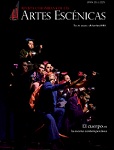Authors
Abstract
In the contemporary theatrical duty things are modified and changed. Theoretical categories that one would think intangible are transformed or even come to disappear. Inside out, specificities apparently antiquated, resurface and develop again. In this context, this is to say, in the contemporary stages, what does the acting duty imply? How does the actor bring about on himself in order to be efficiently operative with the audience? Perhaps the most practical way to answer the questions consists in sketching a list of the different strategies and actor has for being present today in theater. Let’s call them acting modalities. It is possible –to start with- to distinguish between seven modalities: the choreographic or choreographed body, the quotidian body, the ludic body, the discordant body, the dissonant body, the singular body and the over-codified body. The word “body” is used to insist about the outward appearance of the event without forgetting the following truism: The work of the actor is corporal.
References
Chevallier, Jean-Frédéric. (2007). “Tres entradas en lo trágico contemporáneo y un poco más...”. Educación Estética, 3: 253-309. Bogotá: Universidad Nacional de Colombia.
Chevallier, Jean-Frédéric y Batista, Ángeles.(2004). “Investigación en Proyecto 3: provocar los sentidos, dar sentido”. En Coloquio internacional sobre el gesto teatral contemporáneo (pp. 79-90). UNAM/Escenología/Proyecto 3,México.
Deleuze, Gilles. (1968). Différence et répétition.París: Minuit.
________. (1979). “Un manifeste de moins”. En Carmelo Bene y Gilles Deleuze, Superpositions.París: Minuit.
________. (1985). Cinéma 2. L’image-temps.París: Minuit.
Lehmann, Hans-Thies. (2001). Le théâtre postdramtique. Paris: L’Arche. Nancy, Jean-Luc. (2003). Au fond des images.París: Galilée.
Oida, Yoshi. (2003). Un actor a la deriva. México: El Milagro.
Torres, Paola. (2011). “Crónica de cuatro montajes en tres tiempos” (informe académico, Licenciatura en Literatura Dramática y Teatro). UNAM, México.

 PDF (Español)
PDF (Español)
 FLIP
FLIP









